If you're looking to improve your strength and fitness, dumbbells are an excellent piece of equipment to consider. Dumbbells provide a versatile way to perform a wide range of strength exercises. It can help you target specific muscle groups, build muscle mass, and increase your overall fitness level. However, to get the most out of your dumbbell workouts, it's essential to understand the various aspects of using dumbbells set correctly.
In this post, we have covered some essential topics related to dumbbell training. A comparison of dumbbells vs. barbells for strength training, an ultimate dumbbell workout routine for beginners. Tips for incorporating dumbbell exercises into your cardio routine. And the importance of proper form when using dumbbells. Whether you're a beginner or a seasoned fitness enthusiast, this post will provide you with valuable insights into the effectiveness and versatility of dumbbells for strength exercises.
Benefits of Dumbbell Workouts
Dumbbells are versatile fitness equipment that can be used for various workouts. They come in different sizes and shapes, making them perfect for any fitness level. Here are the 10 benefits of incorporating dumbbell workouts into your exercise routine.

Builds Muscle Mass
One of the primary benefits of dumbbell workouts is that they help build muscle mass. Dumbbells are perfect for strength training exercises that target specific muscles. As you lift heavier weights over time, you will see an increase in muscle mass and strength.
Boosts Metabolism
Dumbbell workouts can also help boost your metabolism. When you lift weights, your body burns more calories even after you have finished working out. This is because weightlifting increases your basal metabolic rate, which is the number of calories your body burns at rest.
Increases Bone Density
Regular dumbbell workouts can also help increase bone density. Weightlifting places stress on your bones, which helps to stimulate the growth of new bone tissue. This can help reduce the risk of osteoporosis and other bone-related conditions.
Improves Cardiovascular Health
Dumbbell workouts can also help improve your cardiovascular health. When you lift weights, your heart rate increases, which improves blood flow and oxygen delivery to your muscles. This can help reduce the risk of heart disease and other cardiovascular conditions.
Enhances Athletic Performance
Dumbbell workouts can also enhance your athletic performance. By targeting specific muscles, you can improve your strength, power, and agility. This can be particularly beneficial for athletes who need to perform at their best in their sport.
Increases Flexibility
Dumbbell workouts can also increase your flexibility. By performing exercises that require a full range of motion, you can improve your flexibility and range of motion. This can help reduce the risk of injury and improve your overall physical performance.
Reduces Stress
Dumbbell workouts can also help reduce stress. Exercise releases endorphins, which are natural chemicals that make you feel good. This can help reduce stress, anxiety, and depression.
Improves Posture
Regular dumbbell workouts can also improve your posture. By targeting your back and core muscles, you can strengthen them, which can help improve your posture and reduce the risk of back pain and other related conditions.
Enhances Weight Loss
Dumbbell workouts can also enhance your weight loss efforts. When you lift weights, your body burns more calories, which can help you lose weight faster. In addition, weightlifting can help you build muscle, which can help you burn more calories at rest.
Increases Confidence
Lastly, dumbbell workouts can increase your confidence. As you build muscle and improve your physical performance, you will feel more confident in your abilities. This can translate into other areas of your life, such as your work and personal relationships.
Dumbbells vs. Barbells: Which is Better for Strength Training?
Choosing the right equipment for strength training is an important part of any fitness regimen. Two popular options are dumbbells and barbells. Both types of equipment have their advantages and disadvantages. Let’s take a closer look at the differences between the two and which one may be better for strength training.
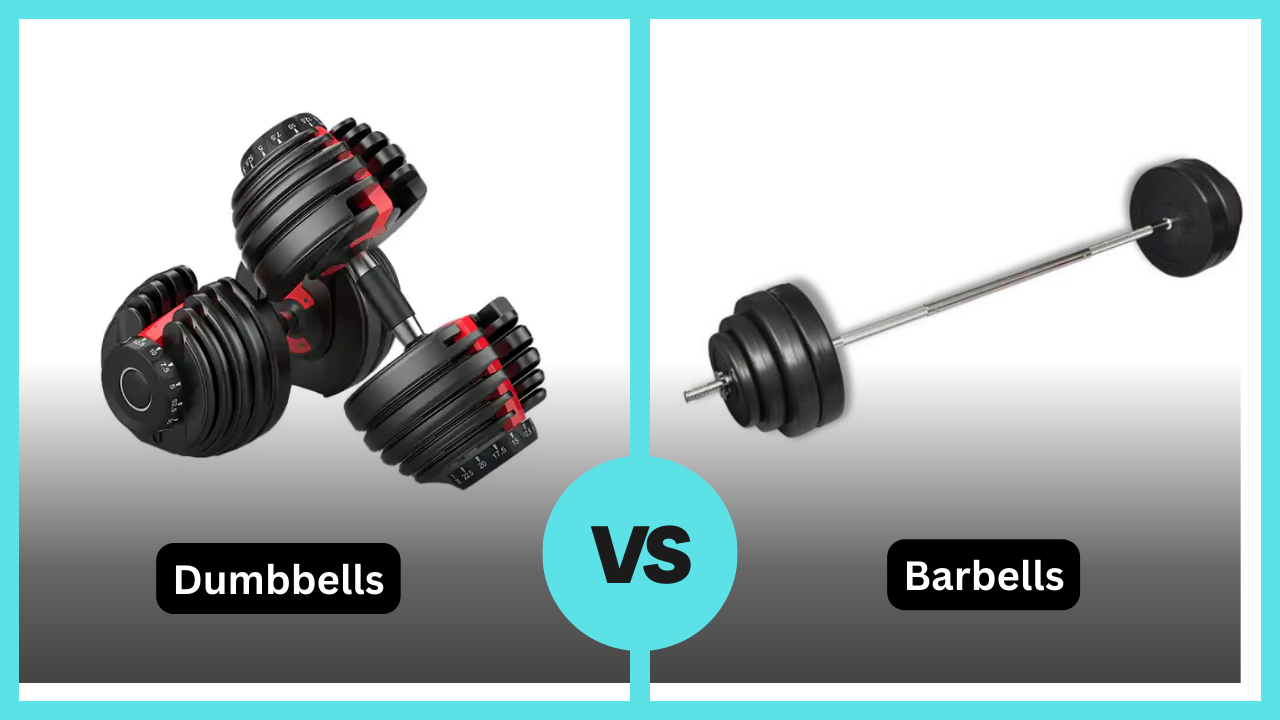
Dumbbells for Strength Training:
Dumbbells are a popular choice for strength training, and for good reason. Here are some of the benefits of using dumbbells:
Versatility: Dumbbells are versatile and can be used for a wide range of exercises. You can use them for both upper and lower-body workouts, as well as for compound exercises that work for multiple muscle groups at once.
Improved Muscle Balance: Dumbbells can help improve muscle balance because they require each side of your body to work independently. This can help to prevent muscle imbalances and reduce the risk of injury.
Greater Range of Motion: Dumbbells allow for a greater range of motion compared to barbells. This is because you can move each arm independently, allowing for a more natural range of motion.
Reduced Injury Risk: Dumbbells are generally considered to be safer than barbells because they are easier to control and require less weight to be effective.
Barbells for Strength Training:
Barbells are another popular option for strength training. Here are some of the benefits of using barbells:
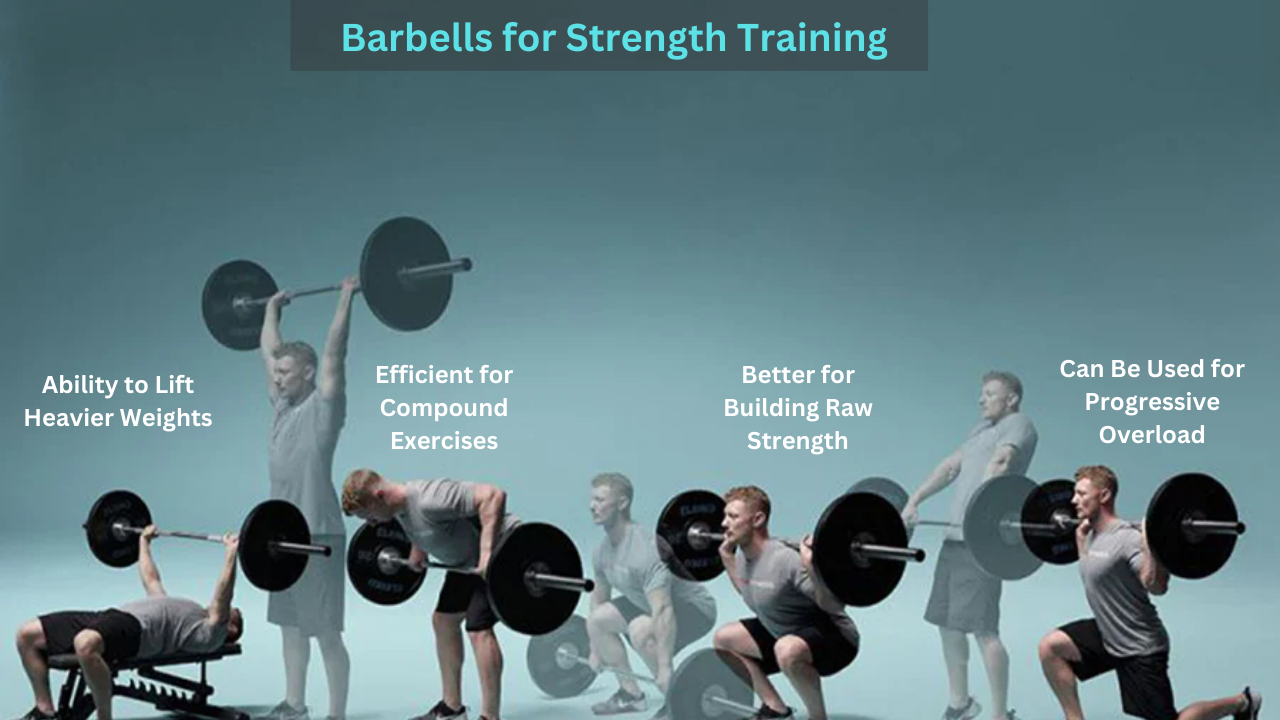
Ability to Lift Heavier Weights: Barbells allow you to lift heavier weights compared to dumbbells. This is because both arms are working together, allowing for more weight to be lifted.
Efficient for Compound Exercises: Barbells are efficient for compound exercises that work for multiple muscle groups at once, such as squats, deadlifts, and bench presses.
Better for Building Raw Strength: Barbells are better for building raw strength because you can lift heavier weights compared to dumbbells. This is important for powerlifting and other strength-focused activities.
Can Be Used for Progressive Overload: Progressive overload is a key principle of strength training, and barbells are better for this because you can add weight more easily and in smaller increments compared to dumbbells.
Both dumbbells and barbells have their advantages and disadvantages, and which one is better for strength training depends on your goals and fitness level. Dumbbells are versatile, improve muscle balance, have a greater range of motion, and are generally safer.
The Ultimate Dumbbell Workout Routine for Beginners
Strength training is an important part of any fitness regimen, but getting started can be intimidating, especially if you’re new to the world of weightlifting. If you’re looking for an effective and easy-to-follow workout routine, look no further than dumbbells.
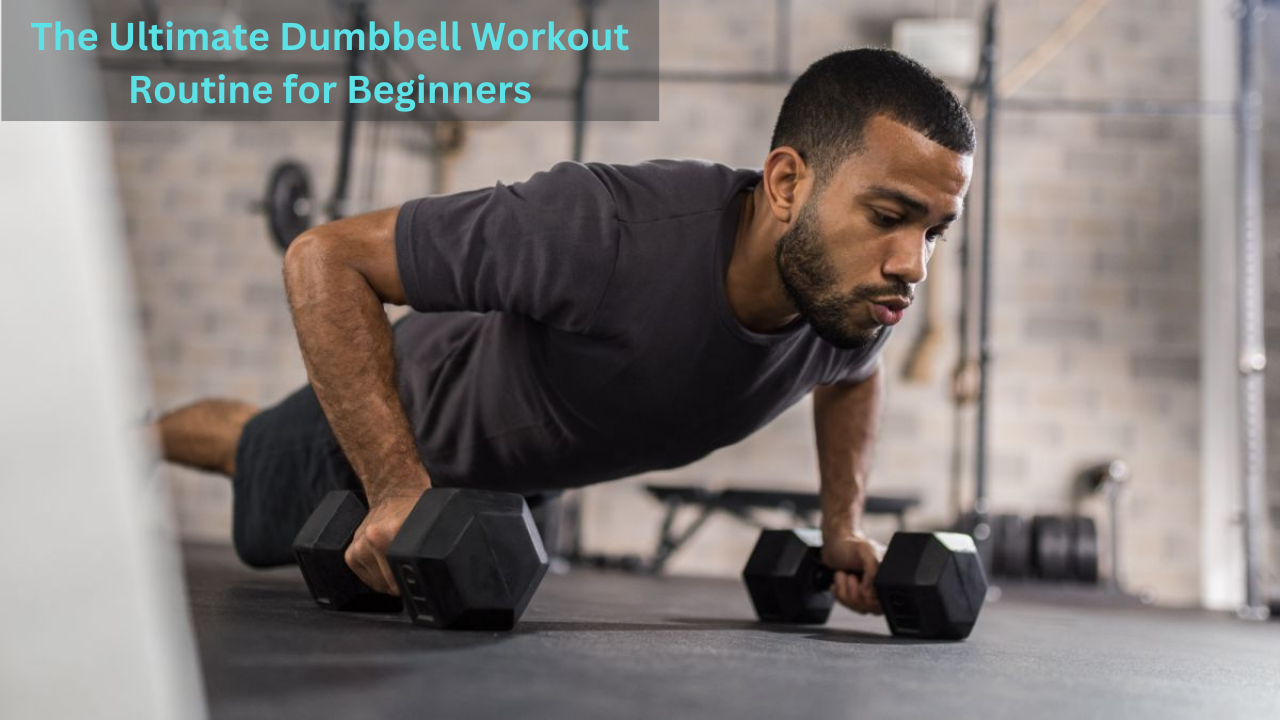
Dumbbells are versatile pieces of equipment that can be used to target a wide range of muscle groups and are perfect for beginners. In this post, we will guide you through the ultimate dumbbell workout routine for beginners.
Warm-Up:
Before you start your dumbbell workout, it’s important to warm up your muscles. A good warm-up can help prevent injury and prepare your muscles for the workout ahead. Here’s a quick and easy warm-up routine you can do before your dumbbell workout:
- Jumping Jacks: 2 sets of 10 reps
- Bodyweight Squats: 2 sets of 10 reps
- Lunges: 2 sets of 10 reps per leg
- Arm Circles: 2 sets of 10 reps (forward and backward)
- Shoulder Rolls: 2 sets of 10 reps (forward and backward)
The Dumbbell Workout Routine:
Now that you’re warmed up and ready to go, let’s dive into the ultimate dumbbell workout routine for beginners. This routine includes exercises that target all major muscle groups, including your chest, back, shoulders, biceps, triceps, legs, and core.
Goblet Squats: 3 sets of 10 reps
Hold a dumbbell with both hands at chest height, stand with your feet shoulder-width apart, and lower your body into a squat position. Keep your back straight and your knees over your toes. Return to the starting position and repeat.
Dumbbell Bench Press: 3 sets of 10 reps
Lie flat on a bench with your feet flat on the floor. Hold a dumbbell in each hand, with your arms extended straight up. Lower the dumbbells until they are level with your chest, and then press them back up.
Dumbbell Rows: 3 sets of 10 reps per arm
Hold a dumbbell in one hand and place your opposite knee and hand on a bench. With your back straight, pull the dumbbell up toward your chest. Lower the dumbbell back down and repeat on the other side.
Dumbbell Shoulder Press: 3 sets of 10 reps
Hold a dumbbell in each hand at shoulder height, with your palms facing forward. Press the dumbbells straight up until your arms are fully extended. Lower the dumbbells back down to shoulder height and repeat.
Dumbbell Bicep Curls: 3 sets of 10 reps per arm
Hold a dumbbell in each hand, with your arms at your sides and your palms facing forward. Curl the dumbbell up toward your shoulder, keeping your elbow stationary. Lower the dumbbell back down and repeat on the other arm.
Tricep Extensions: 3 sets of 10 reps per arm
Hold a dumbbell in one hand and raise it straight up above your head. Lower the dumbbell behind your head, bending your elbow. Raise the dumbbell back up and repeat on the other side.
Plank Rows: 3 sets of 10 reps per arm
Start in a plank position with a dumbbell in one hand. Pull the dumbbell up toward your chest, keeping your elbow close to your body. Lower the dumbbell back down and repeat on the other arm.
Cool Down: After completing your dumbbell workout, it’s important to cool down and stretch your muscles. This can help prevent injury and reduce muscle soreness. Here are a few simple stretches you can do after your dumbbell workout:
Tricep Stretch: Reach one arm up and bend your elbow so your hand is behind your head. Use your other hand to gently pull your elbow towards your head, stretching the tricep muscle. Hold for 15-30 seconds and repeat on the other side.
Shoulder Stretch: Cross one arm across your chest and use your opposite hand to pull it towards your body, stretching your shoulder. Hold for 15-30 seconds and repeat on the other side.
Quad Stretch: Stand with your feet hip-width apart and bend one knee, bringing your foot towards your buttocks. Use your hand to hold your foot and gently pull it towards your buttocks, stretching your quad muscle. Hold for 15-30 seconds and repeat on the other side.
The Importance of Proper Form When Using Dumbbells
While dumbbell exercises can be highly effective in achieving your fitness goals, it is crucial to use proper form and technique to avoid injury and get the most out of your workout. Check out the importance of proper form when using dumbbells and provide tips on how to achieve it.
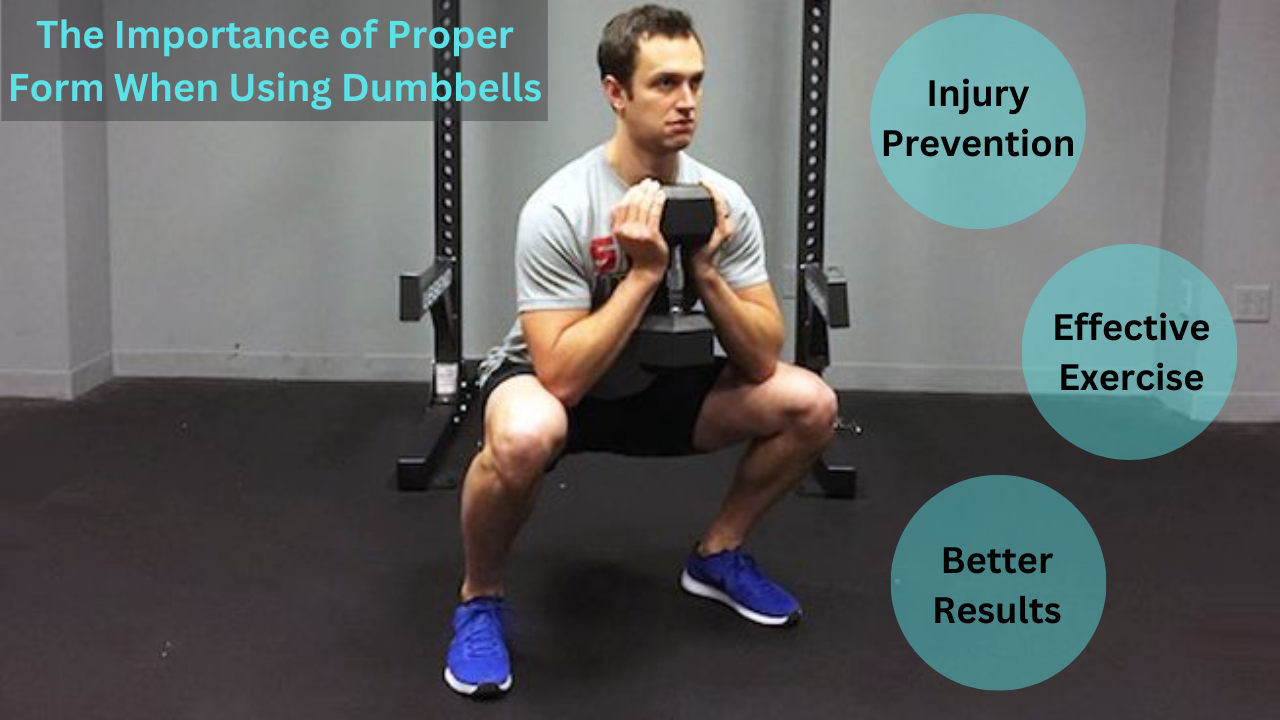
The Importance of Proper Form:
Proper form when using dumbbells is essential for several reasons, including:
Injury prevention: Using proper form when lifting dumbbells can help prevent injuries such as strains, sprains, and muscle tears. Proper form ensures that you are using the correct muscles and placing the right amount of stress on your body.
Effective exercise: Proper form ensures that you are using the correct muscles for each exercise, which allows you to effectively target specific muscle groups and achieve your fitness goals.
Better results: When you use the proper form, you are engaging the correct muscles and maximizing the effectiveness of each exercise, leading to better results.
Tips for Proper Form When Using Dumbbells:
Here are some tips to ensure proper form when using dumbbells:
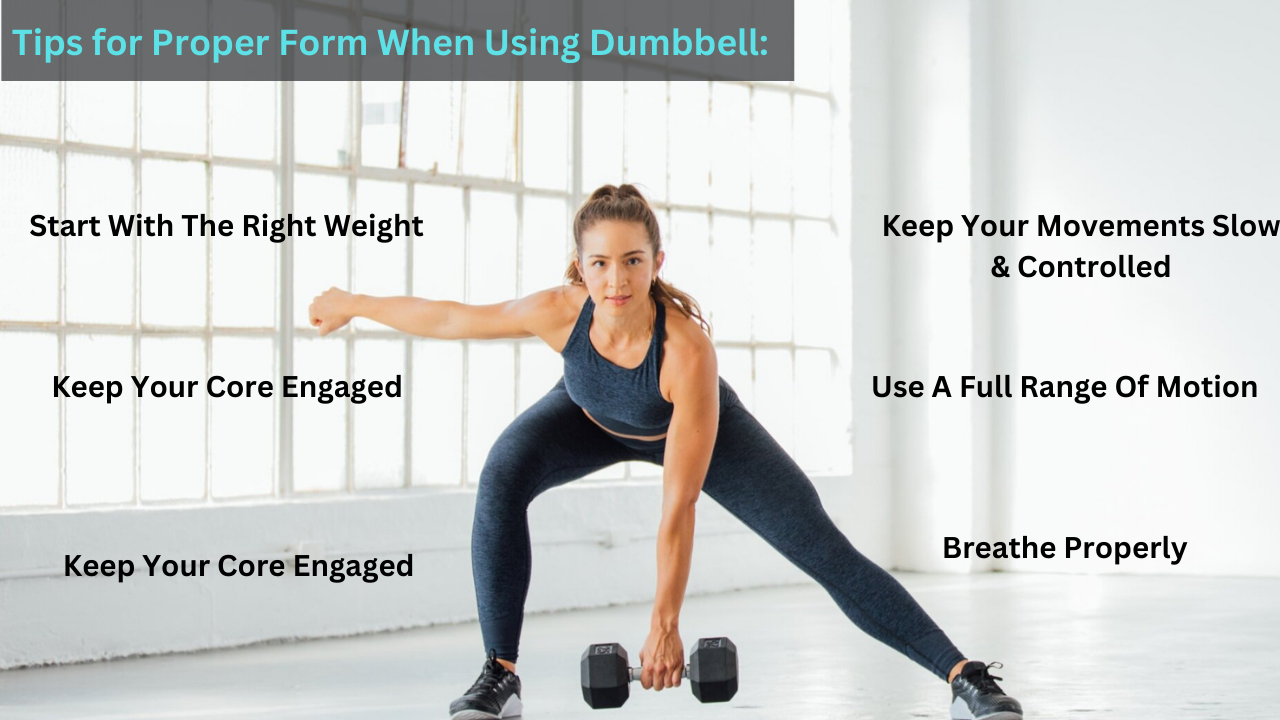
Start with the right weight: It is important to start with a weight that is appropriate for your fitness level. If the weight is too heavy, you may not be able to maintain proper form throughout the exercise.
Keep your core engaged: Keeping your core engaged during dumbbell exercises helps maintain stability and prevent injury.
Maintain proper posture: Proper posture helps ensure that you are engaging the right muscles and using proper form. Keep your shoulders back and down, chest up, and spine neutral.
Keep your movements slow and controlled: Avoid swinging or jerking the dumbbells. Keep your movements slow and controlled, focusing on engaging the target muscles.
Use a full range of motion: Using a full range of motion ensures that you are engaging the full range of muscles and getting the most out of each exercise.
Breathe properly: Remember to breathe throughout the exercise. Inhale during the eccentric (lowering) phase of the exercise and exhale during the concentric (lifting) phase.
Common Mistakes to Avoid:
Here are some common mistakes to avoid when using dumbbells:
Using too much weight: Using too much weight can cause you to lose proper form and increase your risk of injury.
Arching your back: Arching your back during exercises such as bicep curls can put unnecessary strain on your lower back and lead to injury.
Lifting too fast: Lifting too fast can cause you to lose control and compromise your form.
Hunching your shoulders: Hunching your shoulders can cause unnecessary tension in your neck and shoulders and lead to injury.
Conclusion:
Dumbbells are a versatile and effective tool for strength training that can help you achieve your fitness goals. Whether you're a beginner or an experienced athlete, incorporating dumbbells into your workout routine can provide numerous benefits. Such as building muscle mass, improving your cardiovascular health, and enhancing your overall fitness level. With proper form and technique, you can safely and effectively use dumbbells to target specific muscle groups and achieve your desired results. We hope that the information provided in this post has been helpful in guiding you toward a better understanding of the effectiveness and versatility of dumbbells for strength exercises. Remember to always consult with a professional before starting any new exercise routine, and listen to your body to prevent injury and get the most out of your workouts.







